Related Research Articles
The Bronze Star Medal (BSM) is a United States Armed Forces decoration awarded to members of the United States Armed Forces for either heroic achievement, heroic service, meritorious achievement, or meritorious service in a combat zone.
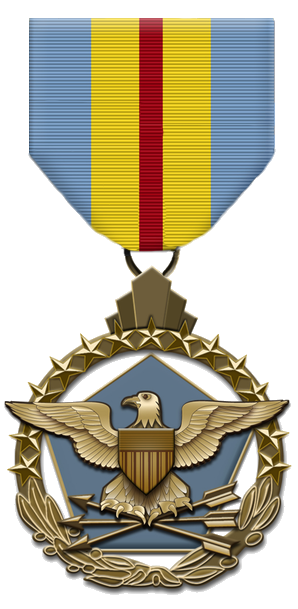
The Defense Distinguished Service Medal is a military decoration of the United States Department of Defense, which is presented to United States Armed Forces service members for exceptionally distinguished performance of duty contributing to the national security or defense of the United States. The medal was created on July 9, 1970, by President Richard Nixon in Executive Order 11545. President Nixon awarded the first medal, on the day the Executive Order was signed, to General Earle Wheeler, who was retiring from the US Army after serving as Chief of Staff of the United States Army and then Chairman of the Joint Chiefs of Staff.

The Silver Star Medal (SSM) is the United States Armed Forces' third-highest military decoration for valor in combat. The Silver Star Medal is awarded primarily to members of the United States Armed Forces for gallantry in action against an enemy of the United States.

The United States secretary of defense (SecDef) is the head of the United States Department of Defense, the executive department of the U.S. Armed Forces, and is a high-ranking member of the federal cabinet. The secretary of defense's position of command and authority over the military is second only to that of the president of the United States, who is the commander-in-chief. This position corresponds to what is generally known as a defense minister in many other countries. The secretary of defense is appointed by the president with the advice and consent of the Senate, and is by custom a member of the Cabinet and by law a member of the National Security Council.

The Prisoner of War Medal is a military award of the United States Armed Forces which was authorized by Congress and signed into law by President Ronald Reagan on 8 November 1985. The United States Code citation for the POW Medal statute is 10 U.S.C. § 1128.

The Distinguished Service Cross (DSC) is the United States Army's second highest military decoration for soldiers who display extraordinary heroism in combat with an armed enemy force. Actions that merit the Distinguished Service Cross must be of such a high degree that they are above those required for all other U.S. combat decorations, but which do not meet the criteria for the Medal of Honor. The Army Distinguished Service Cross is equivalent to the Naval Services' Navy Cross, the Air and Space Forces' Air Force Cross, and the Coast Guard Cross. Prior to the creation of the Air Force Cross in 1960, airmen were awarded the Distinguished Service Cross.
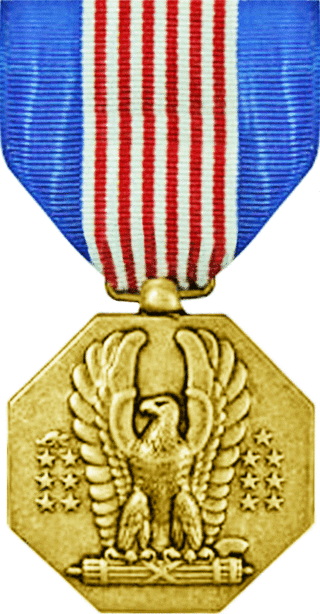
The Soldier's Medal is an individual decoration of the United States Army. It was introduced as Section 11 of the Air Corps Act, passed by the Congress of the United States on July 2, 1926. The Soldier's Medal is equivalent to the Navy and Marine Corps Medal, the Air and Space Forces' Airman's Medal, and the Coast Guard Medal. Prior to the creation of the Airman's Medal in 1960, airmen were awarded the Soldier's Medal.

The Defense Meritorious Service Medal (DMSM) is an award bestowed upon members of the United States military by the United States Department of Defense. In the order of precedence of the United States Armed Forces, it is worn between the Purple Heart and the Meritorious Service Medal. The medal is awarded in the name of the Secretary of Defense to members of the Armed Forces who, while serving in a joint activity, distinguish themselves by non-combat outstanding achievement or meritorious service, but not of a degree to warrant award of the Defense Superior Service Medal.

The Airman's Medal (AmnM) is a military award and decoration of the United States Air Force and United States Space Force for personnel who distinguish themselves by heroism involving voluntary risk of their life not involving actual combat with an armed enemy of the United States. The medal was established on 6 July 1960 by 10 U.S. Code 8750 and is awarded to those service members or those of a friendly nation while serving in any capacity with the U.S. Air Force or U.S. Space Force. The performance must have involved personal hazard or danger.
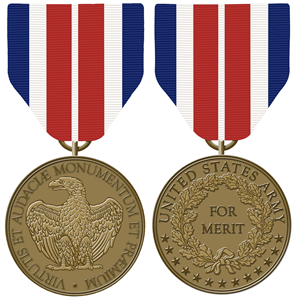
The Certificate of Merit Medal was a military decoration of the United States Army that was issued between the years of 1905 and 1918. The Certificate of Merit Medal replaced the much older Certificate of Merit which was authorized by the United States Congress on March 3, 1847.
A "V" device is a metal 1⁄4-inch (6.4 mm) capital letter "V" with serifs which, when worn on certain decorations awarded by the United States Armed Forces, distinguishes a decoration awarded for combat valor or heroism from the same decoration being awarded for a member's actions under circumstances other than combat.

The Public Safety Officer Medal of Valor is the highest decoration for bravery exhibited by public safety officers in the United States, comparable to the military's Medal of Honor.
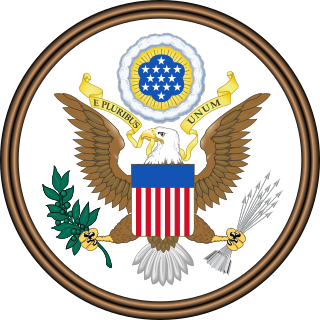
The Stolen Valor Act of 2005, signed into law by President George W. Bush on December 20, 2006, was a U.S. law that broadened the provisions of previous U.S. law addressing the unauthorized wear, manufacture, or sale of any military decorations and medals. The law made it a federal misdemeanor to falsely represent oneself as having received any U.S. military decoration or medal. If convicted, defendants might have been imprisoned for up to six months, unless the decoration lied about is the Medal of Honor, in which case imprisonment could have been up to one year. In United States v. Alvarez (2012), the Supreme Court of the United States ruled that the Stolen Valor Act of 2005 was an unconstitutional abridgment of the freedom of speech under the First Amendment–striking down the law in a 6 to 3 decision.

The Secretary of the Army Award for Valor was an award that acknowledged acts of heroism or bravery connected with a United States Army soldier or Army activity, or that in some way benefits the Army. The equivalent military decoration for this award is the Soldier's Medal.
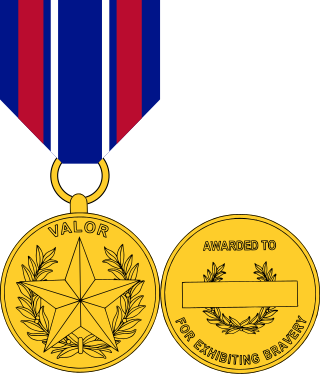
The Office of the Secretary of the Defense Medal for Valor is the highest civilian award for valor presented by the United States Department of Defense. Created in 2001 in the aftermath of the September 11 attacks, the medal recognizes government employees and private citizens who perform an act of heroism or sacrifice, with voluntary risk to their personal safety in the face of danger.
United States v. Alvarez, 567 U.S. 709 (2012), is a landmark decision in which the Supreme Court of the United States ruled that the Stolen Valor Act of 2005 was unconstitutional. The Stolen Valor Act of 2005 was a federal law that criminalized false statements about having a military medal. It had been passed by Congress as an effort to stem instances where people falsely claimed to have earned the medal in an attempt to protect the valor of legitimate recipients. A 6–3 majority of the Supreme Court agreed that the law was unconstitutional and violated the free speech protections under the First Amendment. Despite reaffirming the opinion that was previously issued by the Ninth Circuit, it could not agree on a single rationale. Four justices concluded that a statement's falsity is not enough, by itself, to exclude speech from First Amendment protection. Another two justices concluded that while false statements were entitled to some protection, the Stolen Valor Act of 2005 was invalid because it could have achieved its objectives in less restrictive ways.

Hollister K. Petraeus is a retired Assistant Director at the Consumer Financial Protection Bureau (CFPB), where she headed up the Office of Servicemember Affairs. She retired on January 12, 2017. Her work at the CFPB centered around educating service members on sound financial management and protecting them against predatory lending and cons. She is the wife of retired General David Howell Petraeus.

The Distinguished Warfare Medal was a planned United States military decoration announced by former U.S. Secretary of Defense Leon Panetta on 13 February 2013. It would have been the first U.S. combat-related award to be created since the Bronze Star Medal in 1944. The blue, red and white-ribboned medal was to be awarded to individuals for "extraordinary achievement" related to a military operation occurring after 11 September 2001. It was intended to recognize military achievement in cyberwarfare or combat drone operations for actions that did not include valor in combat.

The Stolen Valor Act of 2013 is a United States federal law that was passed by the 113th United States Congress. The law amends the federal criminal code to make it a crime for a person to fraudulently claim having received a valor award specified in the Act, with the intention of obtaining money, property, or other tangible benefit by convincing another that he or she received the award.
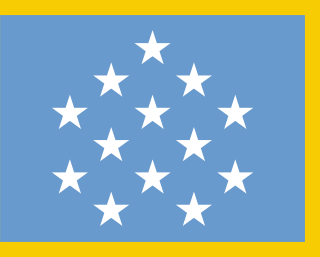
The Medal of Honor (MOH) is the United States Armed Forces' highest military decoration and is awarded to recognize American soldiers, sailors, marines, airmen, guardians, and coast guardsmen who have distinguished themselves by acts of valor. The medal is normally awarded by the President of the United States and is presented "in the name of the United States Congress." It is often, not strictly correctly, referred to as the Congressional Medal of Honor.
References
- ↑ Awards and Decorations Statistics by Conflict, Washington, D.C.: United States Army, 29 June 2012, retrieved 25 July 2012
- ↑ Munoz, Carlo (25 July 2012), "DoD unveils 'Stolen Valor' database", The Hill , Washington, D.C. , retrieved 25 July 2012
- 1 2 Tapper, Jake (23 July 2012), Fighting 'Stolen Valor,' President Obama Announces New Website to Combat Those Falsely Claiming Military Medals, New York City, New York: ABC News , retrieved 25 July 2012
- ↑ Knox, Oliver (24 July 2012), Stolen valor: Obama vows to fight 'contemptible' lies with website, Washington, D.C.: Yahoo! News , retrieved 25 July 2012
- 1 2 Garamone, Jim (25 July 2012), New Website Honors Service Members' Valor, Washington, D.C.: American Forces Press Service, retrieved 25 July 2012
- ↑ valor.defense.gov, Washington D.C.: U.S. Department of Defense, 25 July 2012, retrieved 25 July 2012
- 1 2 Shane, Leo; Carroll, Chris (23 July 2012), DOD will unveil website to combat stolen valor this week, Washington, D.C.: Stars and Stripes , retrieved 25 July 2012